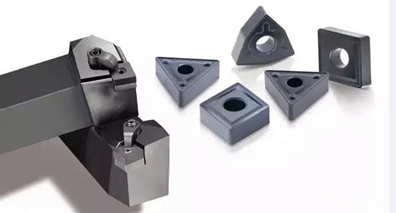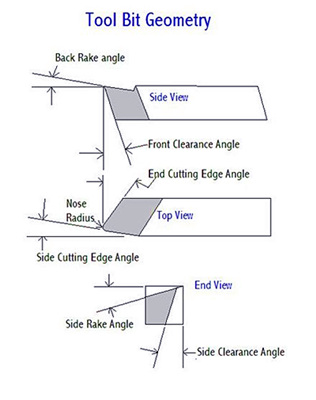
When the workpiece material structure, hardness, allowance is not uniform, the tip is the most vulnerable cutting part of the tool. If the tip first contact with the workpiece, most of the impact force is given the tip, the impact force will break the tip.
1. Rake angle isbid leads to low cutting edge strength
2. Vibration or interrupted cutting caused by insufficient rigidity of the process system is easy to cause edge breakage.
3. When the sharpening quality is not good, the cutting edge is prone to micro-collapse, that is, there is small caving, notch or spalling in the edge area.

Excessive tool wear:
When this happens, the tool will lose some of its cutting power, but will continue to work. As the cutting continues, the damaged part of the edge area may expand rapidly, leading to greater damage.
1. The rigidity of the process system is too poor, resulting in excessive cutting vibration.
2. Insufficient cutting fluid flow or incorrect filling method, resulting in sudden heat and crack loss of the blade.
3. Improve the tool Angle.
4. Appropriately reduce the front and rear angles.
5. Adopt big negative side rake.
6. Reduce the tool cutting edge angle.
7. Use larger negative chamfering or edge arc.
8. Sharpen the transition cutting edge and enhance the tool tip.
9. The edge inclination Angle of discontinuous cutting is best negative or 0.
10. The greater the Angle formed between the main and auxiliary cutting edges, the higher the strength of the large knife, and the smaller the Angle formed between the auxiliary cutting edges and the workpiece can improve the finish of the workpiece.
11. The main deflection Angle formed between the main cutting edge and the cutting plane increases in a certain range to improve the rough turning ability, depending on the shape of the workpiece and the use of the tool.

Methods to improve cutting sharpening:
1. Adopt interrupted grinding or diamond grinding wheel, and grind to 45 degree chamfering.
2. Pay attention to the grinding quality and strictly control the vibration and pendulum of the milling cutter teeth.
3. Reinstall the tool as flat as possible, especially for very small diameter parts.
4. Change the cutter or cutting edge in time.
5. Add auxiliary support to improve clamping rigidity
6. Reduce tool overhang length.
7. Reduce the tool angle appropriately.
8. Use other vibration mitigation measures.
9. Increase the cutting fluid flow
10. Locate the cutting fluid nozzles.
11. Use effective cooling methods such as spray cooling to improve the cooling effect.
12. Hot cracking of the tool.
13. When the cutting tool bears alternating mechanical and thermal loads, it is inevitable to produce alternating thermal stress on the cutting surface due to repeated thermal expansion and contraction, which causes fatigue and cracking of the tool.
For example, in high speed milling of carbide cutters, the teeth are subjected to periodic impact and alternating thermal stress, and comb cracks occur on the front face. Some tools although there is no obvious alternating load and alternating stress, but because of surface, inner layer temperature is not consistent, will also produce thermal stress, coupled with the tool material inside the inevitable defects, so the blade may also crack. Sometimes the tool can continue to work for a period of time after the crack is formed, and sometimes the rapid crack propagation leads to the fracture of the blade or the severe spalling of the tool face.
Measures:
The typical problem of large wear and hot crack is that the hardness of the blade is not enough. Change the high wear resistance blade, but pay attention to whether the strength is enough, otherwise it will collapse. In addition, thermal crack and thermal impact are related, either full cooling, or dry cutting.
---EDITOR: Doris Hu
-----POST: Doris Hu
High-performance diamond composite cutters (PDC) for stone cutting saw blades. Learn key structural features, performance requirements, and selection guidelines for granite, marble, and quarry cutting applications.
Comparison of ns, ps, and fs lasers for PCD, carbide, and ceramic machining, and how Moresuperhard’s 5-axis laser PCD grinding machine delivers high-precision cold laser processing.
Add: Zhongyuan Rd, Zhongyuan District, Zhengzhou, 450001, Henan, China
Tel: +86 17700605088